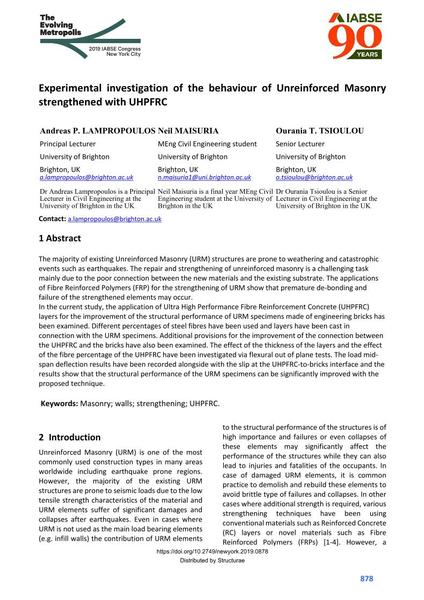Experimental investigation of the behaviour of Unreinforced Masonry strengthened with UHPFRC

|
|
|||||||||||
Détails bibliographiques
| Auteur(s): |
Andreas P. Lampropoulos
(University of Brighton)
Neil Maisuria (University of Brighton) Ourania T. Tsioulou (University of Brighton) |
||||
|---|---|---|---|---|---|
| Médium: | papier de conférence | ||||
| Langue(s): | anglais | ||||
| Conférence: | IABSE Congress: The Evolving Metropolis, New York, NY, USA, 4-6 September 2019 | ||||
| Publié dans: | The Evolving Metropolis | ||||
|
|||||
| Page(s): | 878-883 | ||||
| Nombre total de pages (du PDF): | 6 | ||||
| DOI: | 10.2749/newyork.2019.0878 | ||||
| Abstrait: |
The majority of existing Unreinforced Masonry (URM) structures are prone to weathering and catastrophic events such as earthquakes. The repair and strengthening of unreinforced masonry is a challenging task mainly due to the poor connection between the new materials and the existing substrate. The applications of Fibre Reinforced Polymers (FRP) for the strengthening of URM show that premature de-bonding and failure of the strengthened elements may occur. In the current study, the application of Ultra High Performance Fibre Reinforcement Concrete (UHPFRC) layers for the improvement of the structural performance of URM specimens made of engineering bricks has been examined. Different percentages of steel fibres have been used and layers have been cast in connection with the URM specimens. Additional provisions for the improvement of the connection between the UHPFRC and the bricks have also been examined. The effect of the thickness of the layers and the effect of the fibre percentage of the UHPFRC have been investigated via flexural out of plane tests. The load mid- span deflection results have been recorded alongside with the slip at the UHPFRC-to-bricks interface and the results show that the structural performance of the URM specimens can be significantly improved with the proposed technique. |
||||
| Mots-clé: |
renforcement murs
|
||||
